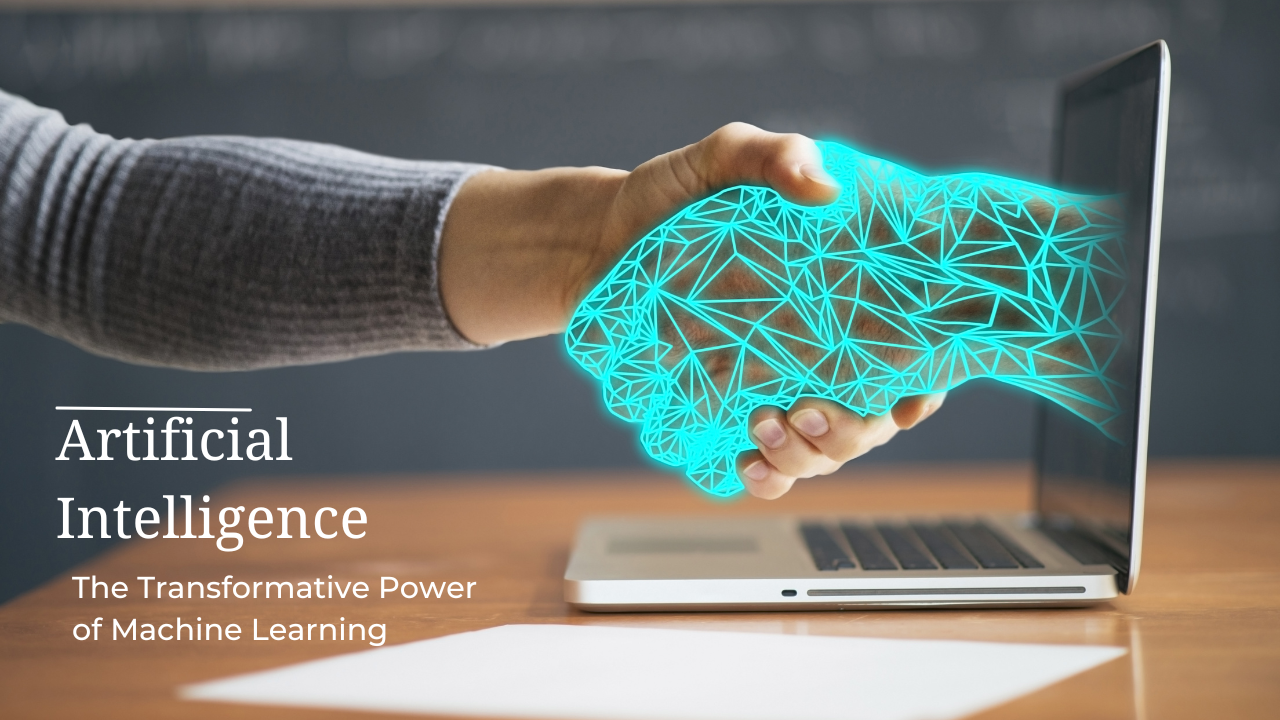The Transformative Power of Artificial Intelligence and Machine Learning
Artificial Intelligence (AI) and Machine Learning (ML) represent two of the most transformative technological advancements of the 21st century. These technologies have the potential to fundamentally change the way we live, work, and interact with the world. From automating mundane tasks to enabling groundbreaking discoveries, AI and ML are at the forefront of a technological revolution that is reshaping industries and redefining possibilities.
Understanding AI and ML
Artificial Intelligence:
Artificial Intelligence refers to the development of computer systems capable of performing tasks that typically require human intelligence. These tasks include understanding natural language, recognizing patterns, solving problems, and making decisions. AI can be categorized into two types: Narrow AI and General AI. Narrow AI is designed to perform a specific task, such as voice recognition or playing chess, while General AI possesses the capability to understand, learn, and apply intelligence broadly, much like a human being. While General AI remains a theoretical concept, Narrow AI applications are already widespread.
Machine Learning: Machine Learning, a subset of AI, involves the creation of algorithms that enable computers to learn from and make predictions or decisions based on data. Unlike traditional programming, where explicit instructions are given to the computer, ML algorithms use statistical techniques to improve their performance as they are exposed to more data. There are several types of ML, including supervised learning, unsupervised learning, and reinforcement learning. Supervised learning involves training a model on a labeled dataset, unsupervised learning finds hidden patterns in unlabeled data, and reinforcement learning trains models through trial and error.
The Evolution of AI and ML
The history of AI and ML dates back to the mid-20th century, with early pioneers such as Alan Turing and John McCarthy laying the foundational concepts. The evolution of these technologies can be divided into several phases:
Early Development (1950s-1970s): The initial phase was characterized by theoretical work and limited practical applications. The Turing Test, proposed by Alan Turing, set a benchmark for evaluating a machine’s ability to exhibit intelligent behavior. During this period, AI research was largely exploratory, focusing on symbolic reasoning and problem-solving.The AI Winter (1980s-1990s): Despite early enthusiasm, progress in AI research slowed due to limitations in computational power and unrealistic expectations. This period, known as the AI Winter, saw reduced funding and interest in AI. However, foundational work continued, particularly in areas such as neural networks and expert systems.
The Machine Learning Renaissance (2000s-Present): Advances in computing power, the availability of large datasets, and breakthroughs in algorithms have led to a resurgence in AI and ML research. The development of deep learning, a subset of ML inspired by the human brain’s neural networks, has been particularly transformative. Deep learning algorithms have demonstrated remarkable capabilities in image and speech recognition, natural language processing, and more.
Applications Across Industries
AI and ML technologies are being applied across various industries, driving innovation and improving efficiency. Here are some notable examples:
Healthcare: AI and ML are revolutionizing healthcare by enabling more accurate diagnostics, personalized treatments, and efficient management of medical records. Machine learning algorithms can analyze medical images to detect diseases such as cancer at an early stage. AI-powered systems assist in predicting patient outcomes and recommending personalized treatment plans based on individual health data. Additionally, AI-driven chatbots provide 24/7 support to patients, answering queries and scheduling appointments.
Finance: The financial industry has embraced AI and ML for tasks such as fraud detection, risk management, and algorithmic trading. Machine learning models analyze transaction patterns to identify potentially fraudulent activities in real-time. AI systems assess creditworthiness by evaluating a wide range of financial data points, leading to more accurate lending decisions. Algorithmic trading platforms use ML to analyze market trends and execute trades at optimal times, maximizing returns.
Retail: In the retail sector, AI and ML enhance customer experiences, optimize supply chains, and improve inventory management. AI-driven recommendation engines analyze customer behavior to provide personalized product suggestions, increasing sales and customer satisfaction. Machine learning algorithms predict demand patterns, helping retailers maintain optimal inventory levels and reduce stockouts. Additionally, AI-powered chatbots assist customers in finding products, answering queries, and processing orders.
Manufacturing: AI and ML technologies are transforming manufacturing by enabling predictive maintenance, quality control, and process optimization. Machine learning models analyze sensor data from machinery to predict potential failures, allowing for proactive maintenance and minimizing downtime. AI systems inspect products for defects during the manufacturing process, ensuring high-quality standards. Furthermore, AI-driven process optimization improves efficiency by identifying bottlenecks and recommending improvements.
Transportation: The transportation industry is undergoing significant changes with the integration of AI and ML. Autonomous vehicles, powered by advanced machine learning algorithms, are being developed to navigate complex environments and improve road safety. AI-driven traffic management systems analyze real-time data to optimize traffic flow and reduce congestion. Additionally, predictive maintenance models for vehicles and infrastructure help in minimizing breakdowns and ensuring smooth operations.
Energy: AI and ML are playing a crucial role in the energy sector by optimizing resource utilization, predicting demand, and managing energy distribution. Machine learning algorithms analyze data from smart grids to predict energy consumption patterns and adjust supply accordingly. AI-driven systems optimize the operation of renewable energy sources, such as wind and solar, by predicting weather conditions and adjusting output. Additionally, predictive maintenance models for energy infrastructure help in reducing downtime and improving efficiency.
Enhancing Efficiency and Productivity
One of the primary benefits of AI and ML technologies is their ability to enhance efficiency and productivity across various domains. By automating repetitive tasks, providing deep insights through data analysis, and optimizing processes, these technologies enable organizations to achieve more with fewer resources.
Automation: AI-powered automation streamlines workflows by handling mundane and repetitive tasks, freeing up human employees to focus on more complex and creative activities. For instance, AI-driven chatbots can manage customer support inquiries, process orders, and provide information, reducing the need for human intervention. In manufacturing, robotic process automation (RPA) systems perform routine tasks such as data entry and assembly line operations, increasing efficiency and accuracy.
Data Analysis: Machine learning algorithms excel at analyzing vast amounts of data, uncovering patterns, and generating actionable insights. Businesses leverage these insights to make informed decisions, identify opportunities, and mitigate risks. For example, predictive analytics models help companies forecast demand, optimize inventory levels, and streamline supply chains. In finance, AI-driven risk assessment models analyze market trends and historical data to make more accurate investment decisions.
Process Optimization: AI and ML technologies optimize processes by identifying inefficiencies and recommending improvements. In logistics, machine learning models optimize routing and scheduling, reducing transportation costs and delivery times. AI-driven process optimization in manufacturing identifies bottlenecks, recommends adjustments, and improves overall efficiency. Additionally, AI-powered energy management systems optimize the distribution and consumption of energy resources, reducing waste and costs.
Ethical and Societal Considerations
As AI and ML technologies become increasingly pervasive, ethical and societal considerations are gaining prominence. Addressing issues such as data privacy, algorithmic bias, and job displacement is crucial to ensuring that these technologies benefit society as a whole.
Data Privacy: The widespread use of AI and ML involves the collection and analysis of vast amounts of personal data. Ensuring data privacy and protecting individuals’ sensitive information is paramount. Organizations must implement robust data protection measures, adhere to regulations such as GDPR, and promote transparency in data usage. Additionally, developing AI systems that prioritize data privacy, such as federated learning, can mitigate risks associated with centralized data storage.
Algorithmic Bias: Machine learning models are trained on historical data, which may contain biases reflecting societal inequalities. If not addressed, these biases can perpetuate and amplify existing disparities. Ensuring fairness and eliminating bias in AI systems require diverse and representative training datasets, as well as rigorous testing and validation processes. Techniques such as fairness-aware machine learning and bias mitigation algorithms are being developed to address these challenges.
Job Displacement: The automation of tasks through AI and ML raises concerns about job displacement and the future of work. While these technologies can enhance productivity and create new job opportunities, they may also render certain roles obsolete. Addressing this challenge requires a focus on reskilling and upskilling the workforce, promoting lifelong learning, and fostering a culture of adaptability. Governments, educational institutions, and businesses must collaborate to provide training programs that equip individuals with the skills needed for the AI-driven economy.
The Future of AI and ML
The future of AI and ML holds immense promise, with continued advancements expected to bring about even more profound changes. Several emerging trends and developments are set to shape the trajectory of these technologies:
Explainable AI: As AI systems become more complex, ensuring their transparency and interpretability is crucial. Explainable AI (XAI) aims to make AI systems more understandable and accountable, enabling users to trust and effectively use these technologies. Techniques such as model interpretability, feature importance analysis, and local explanations are being developed to provide insights into how AI models make decisions.
Natural Language Processing (NLP): Advances in natural language processing are enhancing the capabilities of AI systems to understand and generate human language. NLP technologies are enabling more sophisticated conversational agents, language translation tools, and sentiment analysis applications. With ongoing research in areas such as contextual understanding and language generation, NLP is set to revolutionize human-computer interaction.
AI and IoT Integration: The integration of AI with the Internet of Things (IoT) is creating new possibilities for smart environments and connected devices. AI-driven IoT systems can analyze data from sensors, devices, and networks to make real-time decisions and optimize operations. For example, smart cities use AI to manage traffic, energy consumption, and public services, improving the quality of life for residents.
Quantum Computing: Quantum computing holds the potential to revolutionize AI and ML by enabling the processing of complex computations at unprecedented speeds. Quantum algorithms can solve problems that are currently intractable for classical computers, opening up new frontiers in fields such as cryptography, optimization

